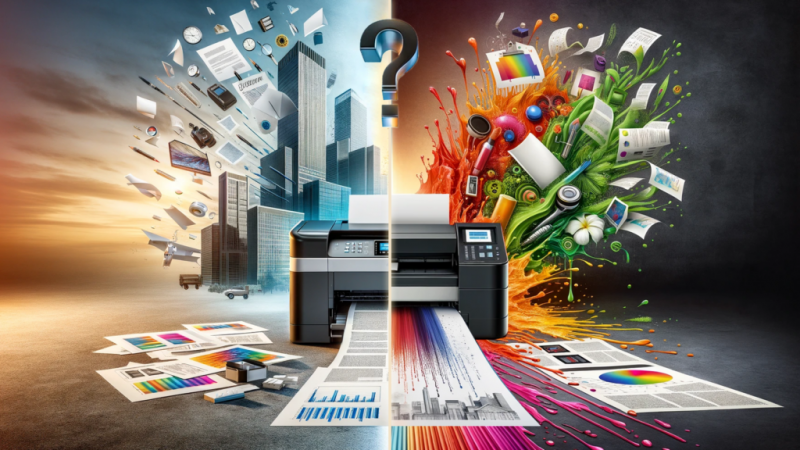A Thorough Printer Technology Comparison, Covering Print Yield, Efficiency, Print Quality, And Maintenance Factors
Everyone Needs Printers
For the average business or enterprise, printing is an indispensable component of day-to-day operations. From healthcare to retail, from legal to banking to nonprofit, every business requires printing devices to interact with its clients, maintain internal documents, create transparency and trust, comply with legal requirements and more.
With various technologies in the market, a common question for a business owner, manager, or procurement specialist is which type of office printers should the organization rely on.
The two most common paper document printing devices in the market are inkjet printers and toner printers, also called laser printers. Both inkjet and laser printers are examples of non-impact printer technology. Non-impact printers do not make direct contact with the paper or ink ribbon. Instead, they leverage xerographic, chemical, electrostatic, or laser technology. This makes them quieter machines — and reduces the number of mechanical components that could malfunction, making both of these good candidates as sustainable printing solutions for the office.
Top 6 Printers for Business in 2024 [Ratings + Reviews]
Not a lot of time? Skip to what you need
- Understanding Inkjet Printers
- Understanding Laser Printers
- Comparing Inkjet & Laser Print Speed and Yield (Print Capacity)
- Comparing Inkjet & Laser Print Resolution
- Printer Languages: Postscript vs. PCL (Printer Control Language)
- Comparing Inkjet & Laser Paper Handling
- Comparing Inkjet & Laser Warm-up Time and “First-Paper-Out” Time (FPOT)
- Comparing Inkjet & Laser Contrast, True Black, and Color Vibrance
- Cost Considerations: Equipment Purchase and Maintenance
- Service Considerations: The Role of an MPS Provider
- The Importance of Selecting a Reliable MPS Provider
- Let Us Help

Understanding Inkjet Printers
Inkjet Printers: Masters of Versatility and Color
Inkjet printers were introduced as cost-effective office printers in the late 1980s and were most known for their versatility. If your business demands top-notch color quality and flexibility in printing on various media, an inkjet printer could be your ideal choice.
The Mechanics of Inkjet Technology
Inkjet printers work by propelling droplets of ink onto paper, creating vibrant and high-resolution images. This technology is particularly useful if you frequently print color-intensive materials, such as marketing brochures or detailed reports, where color accuracy and gradation are crucial.
The Evolution of Inkjet Printers
Since their introduction, inkjet printers have undergone significant enhancements. Today, they offer improved speed, efficiency, and most importantly, reduced operational costs.
Versatility in Media Handling
One of the standout features of inkjet printers is their ability to print on a wide range of media, from glossy photo paper to textured stock. Specialized industrial thermal inkjet printers can print highly legible markings on a wide range of porous and nonporous materials, permitting the printing of QR codes, barcodes, expiration dates, and more. This flexibility can be particularly advantageous if your business requires diverse printing capabilities. It’s a feature that has made inkjet printers a popular choice for businesses that value creative freedom and versatility in their print materials.
Ideal for local, single-office, graphics-centered printing.
An immediate aspect of inkjet printers that makes them attractive to a SMB (small-to-medium sized business) is their upfront cost. The immediate cost of purchasing an inkjet printer is significantly lower than that of a toner printer. For a small local business, this is a compelling argument.
Inkjet printers tend to produce vibrant color prints, making them an attractive option for marketing or sales presentations, photography portfolios and other use cases that rely heavily on graphic elements.
Main Drawbacks of Inkjet Printers
Injet printers become a less affordable option when considering cost of renewables (mainly ink cartridges) in high-yield printing scenarios. Using an inkjet printer to multiple copies of 500-page legal documents becomes absolute folly in terms of cost.
Inkjet printers require regular maintenance, such as cleaning the printhead, and cartridge alignment. Unfortunately, these maintenance tasks often do disregarded in a busy office environment. Additionally, since they’re not really designed for high-yield enterprise use, inkjet printers tend to experience maintenance issues at a much higher rate when forced to produce massive volumes of printing. This leads to a reputation of inkjet printers being ‘finicky’ or ‘fragile’ – an unjust perception that stems mainly from people misusing these printers for heavy workloads and high production cases. (It’s like using a family minivan as a heavy cargo van – its suspension, transmission and engine would be exposed to pressures and rigors they were not ever meants to endure.)
Inkjet printers are also slow – which could present a problem if the business requires large multi-page documents printed with both frequency and urgency.

Understanding Laser Printers
From Inception to Market Dominance
Originally developed in the 1960s, laser printers were introduced to the office equipment market in the 1980s — and quickly gained recognition for their speed, reliability, and exceptional print quality. These high-speed printers were a significant upgrade from the older dot matrix printers, offering businesses a leap in functionality and output quality. You have probably witnessed this evolution firsthand and understand the impact laser printers have had on office efficiency.
The Mechanics of Laser Printing
The true magic of a laser printer is in its precision. Using a laser beam, the laser printer accurately interprets digital commands to produce crisp text and detailed graphics. This precision technology is why, if you’re dealing with high volumes of text-heavy documents regularly, a laser printer could be the most effective tool for your business.
Ideal for High-Volume Printing Environments
When it comes to handling extensive print jobs efficiently, laser printers stand out. Designed for high-volume printing, they offer an optimal solution for businesses where large-scale document printing is a daily requirement. This makes them a go-to choice for environments that prioritize quick, reliable, and high-quality printing.
Main Drawbacks of Laser Printers
Laser printers are meant for high output scenarios. They tend to be bigger machines, taking up more time and typically having a higher upfront cost than an inkjet. This makes them a poor fit for a small, local office. Additionally, the cost of cartridges can run pretty high – which is easy to justify in heavy-production use cases, but may seem an extravagance for a single-office SMB.

Comparing Inkjet & Laser Print Speed and Yield (Print Capacity)
Understanding Print Yield
Print yield refers to the number of pages a printer can produce before needing a refill or maintenance. In this aspect, laser printers often have a higher yield, making them cost-effective for extensive printing tasks. However, inkjet printers have made significant advancements in this area, offering high-yield cartridges that can keep pace with moderate business demands.
Balancing Speed with Demand
When choosing between laser and inkjet printers, it’s important to consider your business’s print volume. Laser printers are typically faster, making them ideal for high-volume printing environments. However, if your print demand is moderate and involves high-quality color prints, an inkjet printer might be more suitable.
Comparing Inkjet & Laser Print Resolution
Achieving Clarity and Detail
The print resolution, measured in dots per inch (DPI), is a crucial factor in determining the quality of your prints. Laser printers generally provide sharp text and clear graphics, ideal for professional documents. Inkjet printers, known for their superior color handling, excel in producing vibrant images and nuanced color gradations, making them a favorite for photographic, artistic or marketing imagery.
Balancing Resolution with Needs
A higher DPI means finer detail in print outputs. While standard resolutions are plenty for most business needs, if your company specializes in graphic design or visual presentations, you might want to invest in a high-resolution inkjet printer.
Printer Languages: Postscript vs. PCL (Printer Control Language)
Decoding Printer Languages
Printer languages are the protocols that printers use to communicate with computing devices. Postscript and PCL (Printer Control Language) are two of the most common printer languages you’ll encounter.
Postscript for Complex Graphics, PCL for Speed and Efficiency
Postscript is often used in environments where complex graphics and images are common. It’s a versatile language that excels in detailed image rendering, making it a preferred choice for design and marketing professionals.
PCL, on the other hand, is tailored for speed and efficiency in document printing. It’s a great fit for office environments where high-volume text printing is the norm. Most laser printers use PCL, offering quick output of documents without compromising on quality.
Comparing Inkjet & Laser Paper Handling
Adapting to Paper Sizes and Types
Both laser and inkjet printers can accommodate a range of paper sizes and types. The key is to ensure the printer you choose aligns with the specific paper-handling requirements of your business. For specialized tasks, such as printing brochures or glossy photos, an inkjet printer usually provides better results.
Tailoring to Your Business’s Needs
When it comes to handling different types of paper, the choice between laser and inkjet printers can be pivotal. Laser printers are well-suited for standard office paper, offering consistent quality and speed. However, if your business requires printing on varied media like photo paper, cardstock, or even fabrics, inkjet printers offer greater versatility.
Comparing Inkjet & Laser Warm-up Time and “First-Paper-Out” Time (FPOT)
Rabbits and Hares: A Quick Start, or Page-After-Page Speed
In fast-paced business environments, the time a printer takes to warm up and produce the first page (FPOT) is crucial. Laser printers typically have a longer warm-up time due to the need to heat the fuser. However, once running, they can produce subsequent pages rapidly. Inkjet printers, on the other hand, generally have shorter warm-up times, making them more efficient for immediate, on-demand printing.
Striking the Right Balance
Consider how the warm-up and FPOT align with your business’s workflow. If continuous printing is common, a laser printer’s longer warm-up time might be a worthwhile trade-off for its speed in longer print runs.
For an office with sporadic printing needs, the quick start-up of inkjet printers could be more beneficial.
Comparing Inkjet & Laser Contrast, True Black, and Color Vibrance
Achieving the Best Visual Impact
The contrast, depth of true black, and color vibrance in your prints can significantly impact their effectiveness. Laser printers are renowned for producing crisp, clear text with true black quality, which is essential for professional documents and sharp presentations. Inkjet printers excel in reproducing vibrant colors and subtle color transitions, making them ideal for colorful graphics, photographs, and marketing materials. The inkjet technology allows for a broader color spectrum and deeper color saturation.
Matching Printer to Purpose
Your choice should reflect the type of documents your business predominantly produces. For text-heavy documents, the clear and sharp output of a laser printer is ideal. For businesses focusing on visual materials, the color vibrancy of inkjet printers will likely serve you better.

Cost Considerations: Equipment Purchase and Maintenance
Balancing Initial Investment with Long-Term Costs
Understanding the cost implications of both inkjet and laser printers is crucial for making an informed decision. Initially, inkjet printers often have a lower purchase price compared to laser printers. However, the cost of ink cartridges can add up, especially if your printing volume is high.
Laser Printers: Economical for High Volume
Laser printers, while generally more expensive upfront, can be more economical in the long run, particularly for businesses with substantial printing needs. Toner cartridges used in laser printers usually have a higher yield than ink cartridges, meaning less frequent replacements and potentially lower long-term costs.
Evaluating Maintenance and Operation Expenses
Beyond the cost of the printer and its consumables, consider the maintenance and operational costs.
Even though inkjet printers have fewer moving parts, their maintenance costs tend to run high due to their constant contact with liquid ink. These printers require routine nozzle cleanings, weekly unit cleanings and filter changes. In reality, the main reason inkjets have a reputation for being fragile or finicky stems from such cleanings going ignored in most office environments, and operational demands placed on them which may exceed their intended purpose.
Laser printers tend to require less maintenance for two reasons: 1) they don’t interact with liquid ink, and 2) built for high volume, they’re generally sturdier in their construction.
Navigating Complex Choices with Expertise
The decision between inkjet and laser printers involves weighing numerous factors, from print quality and speed to cost and volume. For businesses, especially those planning significant investments in printing equipment, the complexity of these choices can be daunting.
Additionally, as is often the case, your office might not have full autonomy over the decision. You might inherit equipment through a merger or acquisition. You might have existing contracts with manufacturers that need to be honored. Whatever the case may be, the truly vital decision is less about the machines — and more about the strategic partner you’ll depend on for all aspects of service, maintenance, inventory expansion and the never ending need to keep up with technology.
Ensuring Dependable Performance
Choosing the right printing devices for your offices is just part of the equation. Ensuring dependable, efficient performance is equally important, and this is where a dependable Managed Print Services (MPS) provider comes into play.
Service Considerations: The Role of an MPS Provider
MPS (Managed Print Services Defined
MPS (Manager Print Services) is the process of bringing all printing operations under a centralized, consolidated management solution. This allows for more trackability, prediction, reporting, and expense management, usually resulting in considerable savings.
Does your organization need managed print services?
Depending on the size of your operation, the number of offices using printers, and the impact of printing costs on your operational budget, an MPS solution may be the right fit. Generally speaking, MPS is best suited for enterprise organizations. It is common for an initial MPS assessment to find upwards of 30 percent more printers than management even knows about, with costs being buried under different line items in various departments.
The Importance of Selecting a Reliable MPS Provider
The Benefits of a Brand-Neutral MPS
A brand-neutral MPS provider offers the flexibility to choose the best equipment for your specific needs, without being tied to a single manufacturer. This approach allows you to select from a wide range of inkjet and laser printers, ensuring a solution that truly matches your business requirements.
Predictive Maintenance and Support
The right managed print services provider will help you achieve predictive maintenance, analyzing usage, wear and tear, and other factors across all printers. This intelligent approach to managing printer maintenance and service issues can significantly reduce downtime and improve efficiency.
Your Partner in Sustainable Printing Solutions
At Flex Technology Group, we understand all these challenges and offer unbiased, expert advice tailored to your specific business situation and needs. Flex Technology Group is by far the leading brand-neutral MPS provider in the nation, with vast experience in complex, large-scale implementations. Our team of experts will ask the right questions to help you navigate these decisions, ensuring that your investment in printing technology is sound and suited to your unique operational demands.
Whether your business needs require the vibrancy and versatility of inkjet printers or the speed and efficiency of laser printers, or a hybrid fleet best suits your business, Flex Technology Group is here to guide you every step of the way. Our commitment is to provide solutions that not only meet but exceed your expectations, delivering value and performance that drive your business forward.
Let Us Help
Whether it’s choosing the right type of printer for one or many offices, looking at long-term printer solutions or ensuring printer maintenance and service is under control, navigating the intricate landscape of automated office equipment involves more than just a superficial understanding of each technology. These purchasing and management decisions impact your business’s operational efficiency, cost-effectiveness, and reputation.
If you feel your organization could benefit from a predictive rather than reactive approach to printing, I encourage you to reach out to our experts. Our team at Flex Technology Group will provide you with personalized, unbiased advice, asking all the key questions to tailor the solution to your business’s unique situation and needs.
Let us help you make an informed decision that best meets your business needs.
We are more then happy to answer any question you have.
